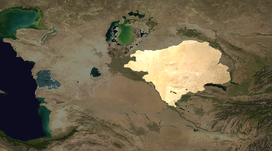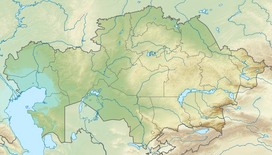Kyzylkum Desert
| Kyzylkum Desert | |
|---|---|
| kyzyl-kum | |
 Map of Kyzyl Kum | |
| Area | 298,000 km2 (115,000 sq mi) |
| Geography | |
| Country | Kazakhstan and Uzbekistan |
| Coordinates | 42°26′28″N 63°27′41″E / 42.44111°N 63.46139°E |
The Kyzylkum Desert (
. It covers about 298,000 km2 (115,000 sq mi).Geography
Kyzylkum is mainly located in Uzbekistan. Its territory consists mainly of an extensive plain at an altitude up to 300 m (980 ft) above
Fauna
Desert fauna include the Russian tortoise (Testudo horsfieldii) and a large lizard known as the Transcaspian or desert monitor (Varanus griseus), which can reach lengths of 1.6 m (5.2 ft). The saiga antelope (Saiga tatarica) also occasionally migrates through the northern part of the desert.
Kyzylkum Nature Reserve in
Djeyran Reserve is located 40 km (25 mi) south of Bukhara. The total area of this reserve is 51,450 km2 (19,860 sq mi). It is a breeding centre for rare species such as goitered gazelle (Gazella subgutturosa), Przewalski's horse (Equus ferus przewalskii), Turkmenian kulan (Equus hemionus kulan) and MacQueen's bustard (Chlamydotis macqueenii). The reserve was founded in 1977 on the enclosed area in 5,131 ha (19.81 sq mi).
Paleontology

The Kyzylkum Desert has exposed
Economy
The local population uses the large spaces of the Kyzylkum Desert as a pasture for livestock (mostly sheep, Bactrian camels and dromedaries).
The desert is well known for its deposits of
See also
- Andronovo culture
- Aydar Lake, large artificial lake
- Central Asian northern desert, an ecoregion largely corresponding with the Kyzylkum Desert
- Karakum Desert, another desert of Central Asia
- List of deserts by area
- Sarmishsay, ancient monuments of anthropogenic activity
References
- ^ Mapping Mongolia: Situating Mongolia in the World from Geologic Time to the Present, Paula L.W. Sabloff, P.62
- ^ ISBN 0-520-24209-2.
- ^ a b Nesov, Lev A. "Mesozoic and Paleogene birds of the USSR and their paleoenvironments". In Campbell Kenneth E. Jr. (ed.). Papers in Avian Paleontology Honoring Pierce Brodkorb. Natural History Museum of Los Angeles County Science Series 36. Los Angeles, CA: Natural History Museum of Los Angeles County. pp. 465–478.
- ISBN 0-521-55476-4.
- ISBN 0-521-55476-4.
- ISBN 0-521-55476-4.
- ISBN 0-521-55476-4.
External links
![]() Media related to Kyzyl Kum at Wikimedia Commons
Media related to Kyzyl Kum at Wikimedia Commons
- Slideshow: Across Central Asia’s Empty Core – Walking the caravan routes of the Kyzyl Kum desert


